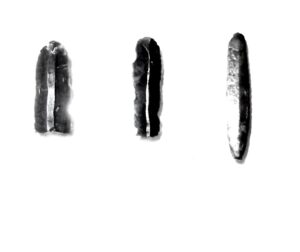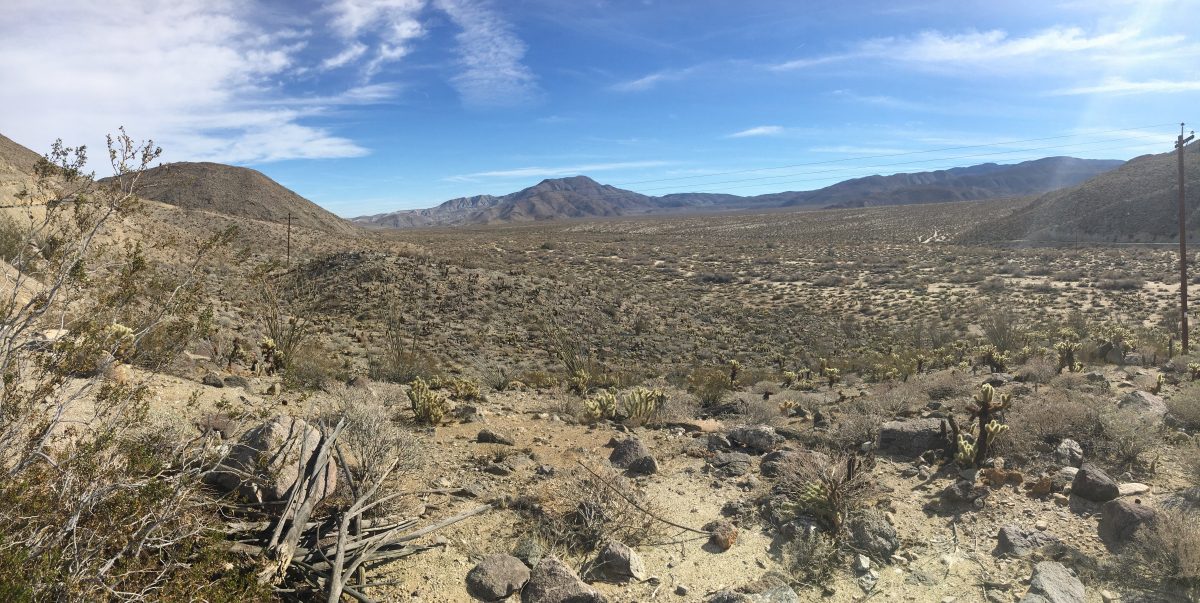Why did Mycenaean artisans of the Late Helladic II period (ca. 1600-1400 BC) create a silver skeuomorph of an ordinary obsidian pressure-flaked prismatic blade? The skeuomorph in question is on display in the Archaeological Museum in Nafplio (Argolid, Greece) in an exhibit case with finds from an elite tholos tomb at Kazarma. We noticed it some years ago and we hoped to find additional information about it or similar objects before now. But so far, no luck. This blog post is an effort therefore to solicit suggestions about the use of the silver blade or references to other examples.
The Kazarma tholos was discovered and excavated in the 1960s along the modern road to ancient Epidauros approximately 15 km east of Nafplio (Keramidas et al. 2021). Three undisturbed burial shafts in the floor of the tholos contained grave goods now on display in the Nafplio museum. Among these grave goods are two obsidian blade segments (proximal) and a complete and intact blade of silver in the form an obsidian blade. The silver blade appears to have been fashioned—probably cast (note the surface bubbling)—in the form of an obsidian prismatic blade with a platform, bulb of percussion, and a curving distal end, elements that are characteristic of a knapped stone implement.

Prismatic blades pressure-flaked from flat cores are a major component of lithic technology in the Aegean Bronze Age (ca. 3300-1200 BC) and are especially common on sites on the central/south mainland and the islands of Greece (Hartenberger and Runnels 2001; Kardulias and Runnels 1995; Runnels 1985). Metal skeuomorphs of obsidian blades are unknown to us despite examining hundreds of thousands of Bronze Age stone tools in the Aegean world over a period of 50 years, though Tristan Carter (personal communication) recalls a copper-alloy blade skeuomorph in an EBA grave at Iasos.
We have a few speculations about its possible function. There are no signs of suspension, which seems to rule out its use as jewel such as a pendant. Because it was found in a mortuary assemblage it possibly had talismanic or apotropaic functions, though no parallels for such usages come readily to mind. Did it have a symbolic function, perhaps preserving in a valuable material the essence of the stone tools that could be used in the afterlife? Is it possible that the obsidian blades displayed alongside the skeuomorph functioned as razors (Runnels 1985) and the silver blade was intended to have a permanent function of this sort?
Of the many speculations that we have considered, one offers an intriguing possibility. Could the silver blade be a form of specie or commodity money in a currency system based on obsidian prismatic blades?
To have a currency system several qualifications must be considered. First, there must be some form of specie (money as it is generally conceived) to effect transactions. Obsidian prismatic blades could have served as specie in the Bronze Age because they meet general requirements for money. Obsidian was imported to the Greek mainland principally from one source, the Cycladic island of Melos, and thus the raw material was limited in supply. It was thus possible for the supply of obsidian to be controlled by communities near the places of import. Political control could be exerted over its use by monopolizing, for example, the production of parallel-sided prismatic pressure-flaked blades by craft specialist flintknappers. This practice has been documented for the southern Argolid, a few kilometers south of the Kazarma tholos tomb. During the Early Bronze Age, blade cores are concentrated at one large site (Fournoi Focus) and only blades or parts of blades are found on small outlying communities in the region. This suggests centralized control over the production and distribution of the imported blades (Jameson et al. 1994; Kardulias and Runnels 1995). Craft specialists were able to standardize the length, width, thickness, and mass of obsidian prismatic blades making them potentially useful as units of value (Hartenberger and Runnels 2001). The blades can also be snapped into smaller pieces of approximately equal size allowing for the fractionalization of the standard units. In this way users could tell how many blades or units were involved and how many fractions might be in “circulation” because they could visually distinguish proximal, medial, and distal elements of a blade to know whether it had been altered since manufacture.
We hypothesize that obsidian blades were units of currency (specie) and the silver skeuomorph was hypothetically a multiple of obsidian units. As an example of the sort of thing we think of the various copper skeuomorphs used in the early Roman Republic as specie, such as aes rude and aes formatum, particularly the latter where copper was cast in the form of seashells and other quotidian objects. It is interesting to note that in the Kazarma tholos one of the burials (Shaft III) contained items of a potentially commercial nature, viz. “two bronze discs, parts of a scale pan [and] more than 170 beads of amethyst, and several ivory discs” (Keramidas et al. 2021: 481) an observation that at least does not contradict the possibility that the obsidian and silver blades were specie used in transactions.
Against the foregoing hypothesis we must acknowledge that there is at present no evidence that obsidian in any form was used as a form of specie in the Aegean world at any time. Furthermore, if the sliver Kazarma skeuomorph was a high value denomination of a hypothetical obsidian blade currency, one would expect to find metal blades in many contexts, not just as grave goods. And so far as we know, the Kazarma skeuomorph is the only example of this kind of artifact, at least in the Mycenaean period.
But if the silver skeuomorph of an obsidian prismatic blade is not a form of specie or money, then what was its purpose?
References
Hartenberger, B., and C. Runnels, 2001, “The Organization of Flaked Stone Production at Bronze Age Lerna,” Hesperia 70: 255-283.
Jameson, J. H., C. N. Runnels, and Tj. H. van Andel, 1994, A Greek Countryside: The Southern Argolid from Prehistory to the Present Day. Stanford University Press, Stanford.
Kardulias, P. N., and C. Runnels, 1995, “The Lithic Artifacts: Flaked Stone and Other Nonflaked Lithics,” in C. Runnels, D. Pullen, and S. Langdon, eds., Artifact and Assemblage. Stanford: Stanford University Press, pp. 74-139.
Keramidas, S., S. Spyropoulou, and A. Vassilopoulou, 2021, “Placing the Kazarma tholos tomb within the early Mycenaean Argolid,” in B. Eder and M. Zavadil, eds., Social Place and Space in Early Mycenaean Greece, Mykenische Studien 35: 479-500.
Runnels, C., 1985, “The Bronze-Age flaked-stone industries from Lerna: a preliminary report,” Hesperia 54: 357-391.
